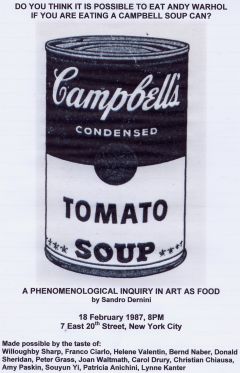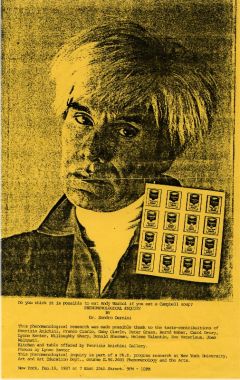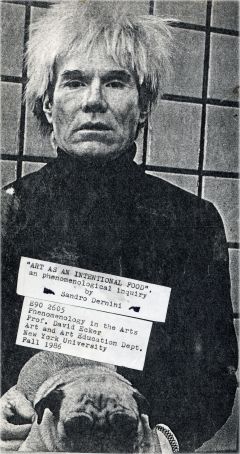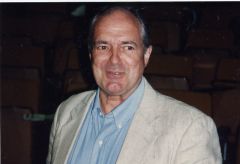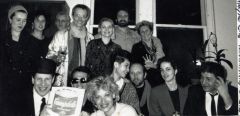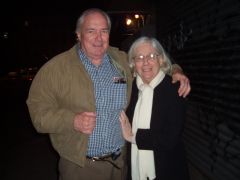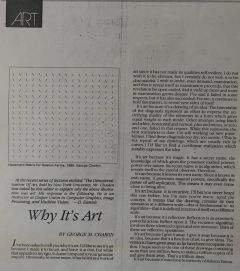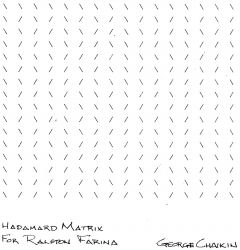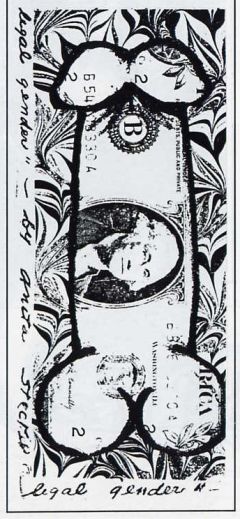![]()
CHANGE IN PERCEPTION AND CONSCIOUSNESS
ARE WE CANNIBALS?
IS IT POSSIBLE TO DIGEST ANDY WARHOL BY EATING A PLEXUS CAMPBOLL'S SOUP CAN?
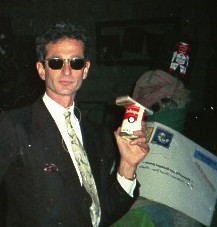
On 18 February 1987, in New York, at the Patrizia Anichini Gallery, I RITUALLY performed "Do you think it is possible to eat Andy Warhol if you are eating a Campbell soup? as an aesthetic inquiry for my PhD course E90.2605 on Phenomenology and the Arts at New York University, directed by prof. David W. Ecker.
Invited artists were Willoughby Sharp, Helen Valentin, Bernd Naber, Franco Ciarlo, Donald Sheridan, Peter Grass, Lynne Kanter, Souyun Yi, Carol Drury, Amy Paskin, Christian Chiansa, and the host Patrizia Anichini.
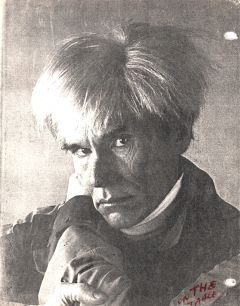
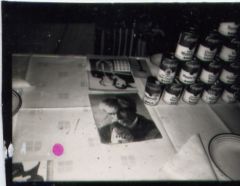

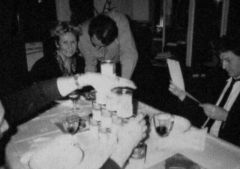
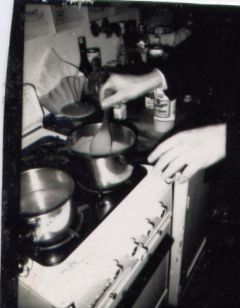
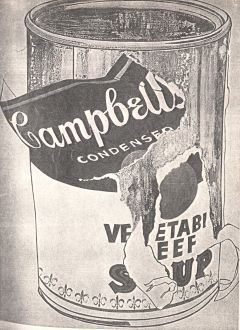
I prepared a questionnaire to be filled by participant artists after having cooked and eaten a Campbell's soup can. Seven questions I posed in the questionnaire, conceived for my phenomenological performance upon my NYU PhD course on Phenomenology and the Arts and my PhD reaserch study on "ART AS FOOD".
QUESTIONNAIRE
Do you think it is possible that you have eaten Andy Warhol when before you have eateen that Campbell soup two minutes ago?
- Suspend your belief before to answer to these questions. Answer: yes or no?
- What you mean?
- How do you know?
- How was the taste?
- Is it true or not?
- Who was the subject? Who was the object?
- Description of the experience


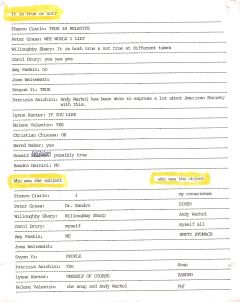
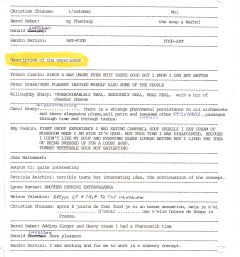


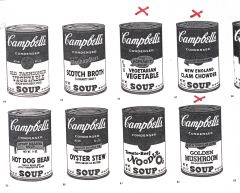
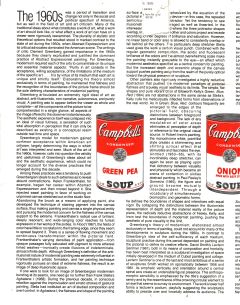
From the artist answers to the questionnaire, the majority of believed they “ate” Andy Warhol dematerialized.
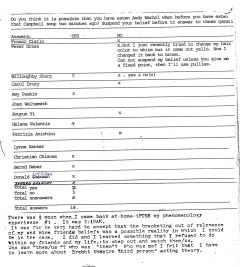
I prepared my phenomenological performance, by being inspired for moving forward my NYU Ph.D inquiry on "ART AS FOOD", by the symposium The Dematerialization of Art, organized the day after at New York University by Angiola Churchill and Jorge Glusberg, co-directors of ICASA (International Center for Advanced Studies in Art), where I was working as a graduate assistant of prof. Churchill, chair of the NYU Art and Art Education Dept.
Angiola Churchill and David Ecker
"Heisenberg's Uncertainty Principle of 1907 with its recognition that the behaviour of the atom could not be predicted proposed a new reality that the artist has only begun to grapple with. What is the status of art if a discernible reality no longer exists?
Advanced technology has vastly expanded the human sensorium. What results from this increase of information largely depends on the interpretative abilities of the artist.
Scientific breakthroughs have presented not just a new version of reality but also of time and space.
What significance this will have for art cannot yet be said but we are clearly on the brink of the most extraordinary leap in human perception".
(From the brochure of the Symposium on The Dematerialization of Art, International Center for Advanced Studies in Art, New York University, 1987)
Few nights after, on 22 February, Andy Warhol died!

At the opening of the Symposium, Lenny Horowitz and Stephen Di Lauro, two Plexus historical players, by reporting from the floor the Sandro's performance, questioned the panelist about this potential dematerialization of Andy Warhol into a Campbell's soup can.
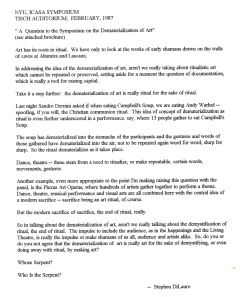
Nam June Paik, among the speakers, answered believed possible that Andy Warhol had been dematerialized through the artist intentional act of eating his commodity art symbol.
The panelists were Jean Baudrillard, Donald Kuspit, Vito Acconci, Nam June Paik, Judy Barry, Dennis Oppenheim, Billy Kluver, Nancy Holt, Paul Taylor, Bruce Breland, Flor Bex, Rene Berger, Eika Billeter, Alan Bowness, Julie Lawson, Hervè Fischer and George Chaikin.
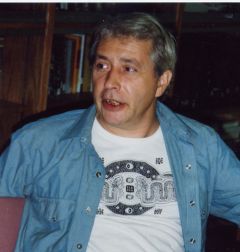
Hadamard Matrix Why it is Art
by George Chaikin, 1987
The Dematerialization of Art Symposium, ICASA International Advanced Studies in Art, New York University 1987
I’ve been asked to tell you why it’s art. I’d like to say it’s art because I made it to be art, and leave it at that, but while that appeals to my ego, it doesn’t respond to your genuine inquiry. Obviously, in some sense, it has failed as a work of art since it has not made its qualities self-evident. I do not wish it to be obvious, but I certainly do not wish it to be obscurantist. I wish to invite, even demand, examination, and that it reveals itself as examination proceeds, that this revelation be open ended, that it yield up more and more as examination grows deeper. I’ve said it failed in some respects, but it has also succeeded. For me, it continues to hold fascination, to reveal new sides of itself.
It’s art because it’s a drawing of an idea. The bimodality of the diagonals represents an effort to express the underlying duality of the elements in a form which gives equal weight to each mode. Other attempts using black and white, horizontal and vertical, plus and minus, or zero and one, failed in this respect. While this represents the best realization to date. I’m still working on new possibilities. I find these diagonals too dry, too ascetic. (This is not typical of my drawings, which are usually rich in curves.) I’d like to find a curvilinear realization which suitably expresses the idea.
It’s art because it’s magic. It has a secret name, the knowledge of which gives the possessor exalted powers, power over nature. Its secret name is its algorithm, which reveals itself to be careful observer. Therefore…
it’s art because it knows its own name.. Since it knows its own name, it possesses magical powers, specifically the power of self-replication. This means it may even come close to being alive.
It’s art because it is recursive. I’ll bet you never heard this one before, but I’m sure you’ve encountered the concept. It means that drawing contains its own reiteration at a different scale – this is fundamental to its algorithm – that it is defined in terms of itself on a different scale.
It’s art because it’s reflective. Reflection is an extremely powerful action. Reflect upon it. The recursive algorithm involves three identical copies and one inversion. Both of these are reflective operations.
It’s art because I give it away. I give it away because it is anidea, because yjay’s function of art, ti give ideas. The versions I have giving away so far been too sparse, too thin. I hope soon to do of these drawings containing more that one million lines, to make a million copies of it and give them away. That’s a trillion lines.
It’s art because it was done in memory of Ralston Farina
THE PLEXUS CIRVILINEAR GEOMETRY OF CONSCIOUNESS
In 1986, at the Plexus Art Opera n.3 "EVE- Escaping from Anno Domini" on board an art slaves ship, hundreds George's Hadamard Matrix copies were given away by Stephen DiLauro, acting as Lorenzo de' Medici, throughing them out the,m together with copies of the penis legal gender dollar by Anita Steckel while artists were sold in auctions were bought by the Royal ArtWorld Family.

